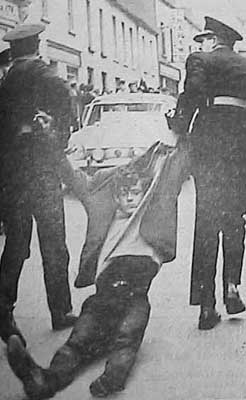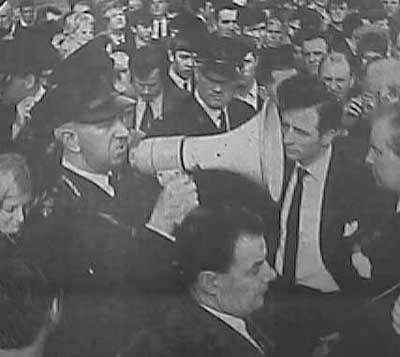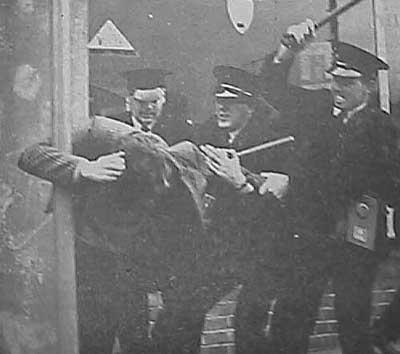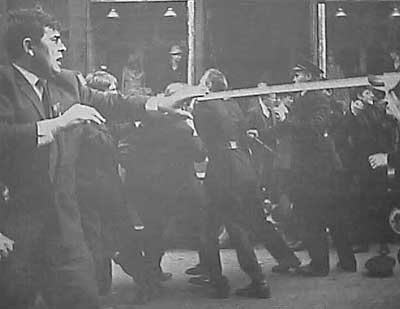
The Derry March - Main Events of the Day[KEY_EVENTS] [Key_Issues] [Conflict_Background] DERRY MARCH: [Menu] [Reading] [Summary] [Background] [Chronology] [Events] [Sources] Material is added to this site on a regular basis - information on this page may change Main Events of the dayThe march in Derry on 5 October 1968 was notionally organised by an ad hoc committee comprising representatives of the Derry Labour Party, the Derry Labour Party Young Socialists, the Derry Housing Action Committee (DHAC), the Derry City Republican Club, and the James Connolly Society. In reality the ad hoc committee never functioned as expected and the practical organisation of the event was undertaken by two people, Eamonn McCann and Eamon Melaugh. The night before the march there was a final meeting between representatives of the Northern Ireland Civil Rights Association (NICRA) and the organisers in Derry. The NICRA wanted to call off the march because of the banning order imposed by William Craig, then Home Affairs Minister at Stormont. After some discussion it was decided to go ahead with the march.
Estimates of the number of people who took part in the march vary
widely. For many such events the organisers tend to inflate estimates
of the numbers who took part while official figures tend to be
a more conservative estimate. Surprisingly therefore one of the
main organisers, Eamonn McCann, stated that "about 400 hundred
people formed up in ranks in Duke Street. About two hundred stood
on the pavement and looked on." (McCann, 1993; p.97), while
the official estimate was approximately 2,000 people (Cameron
Report, 1969; p.27). Among those who were present at the march
were: representatives of the five local groups who were part of
the ad hoc committee and members of the NICRA; a number of Nationalist
Members of the Northern Ireland Parliament (NIMPs) including Eddie
McAteer and Gerry Fitt and three Westminster Labour MPs; individuals
such as John Hume; and many ordinary citizens of Derry. The fact
that the organisers had miscalculated and planned the march for
a day when the Derry City Football Club was playing 'at home',
the fact that the march was starting in the Waterside, or the
expectation that there might be an outbreak of violence, all probably
contributed to the low numbers. The march was however about to
achieve a significance far beyond its size.
 While the injured were being taken away to hospital an impromptu meeting
was held in front of the police line and the crowd was addressed
by a number of speakers. A short time later the County Inspector
of the RUC gave an order to his officers to disperse the march.
The two police lines drew their batons and moved towards the
marchers. Even the official report concluded that the police
broke ranks at this point and "used their batons indiscriminately
on people in Duke Street" (Cameron Report, 1969; p.29).
The crowd scattered and made their way across Craigavon Bridge
having first run the gauntlet of the police lines. On the bridge
the water canons were used on the dispersing marchers and Saturday
afternoon shoppers making their way home.
While the injured were being taken away to hospital an impromptu meeting
was held in front of the police line and the crowd was addressed
by a number of speakers. A short time later the County Inspector
of the RUC gave an order to his officers to disperse the march.
The two police lines drew their batons and moved towards the
marchers. Even the official report concluded that the police
broke ranks at this point and "used their batons indiscriminately
on people in Duke Street" (Cameron Report, 1969; p.29).
The crowd scattered and made their way across Craigavon Bridge
having first run the gauntlet of the police lines. On the bridge
the water canons were used on the dispersing marchers and Saturday
afternoon shoppers making their way home.
The official report put the number of casualties as 4 RUC officers
and 77 civilians. The organisers of the march estimated that
the total number of people who went to hospital for treatment
was approximately 100, although many others would have received
first aid on the street and not attended the casualty department
of the hospital.
The events of 5 October 1968 were recorded by press and television
reporters. These reports appeared in newspapers and on television
the following day and were seen not only in Ireland and Britain
but around the world. The scenes were to prove shocking to many
people across the United Kingdom but they had a profound impact
on the Catholic / Nationalist population of Northern Ireland.
Until this point in time consecutive British governments had been
content to ignore how Unionists in Northern Ireland had governed
the region. The events in Derry on 5 October 1968, and those
which followed as a direct consequence, were to meant that the British
government would be forced to take a more active involvement in
the running of the state.
|
CAIN
contains information and source material on the conflict
and politics in Northern Ireland. CAIN is based within Ulster University. |
|
|
|||
|
Last modified :
|
||
|
| ||


